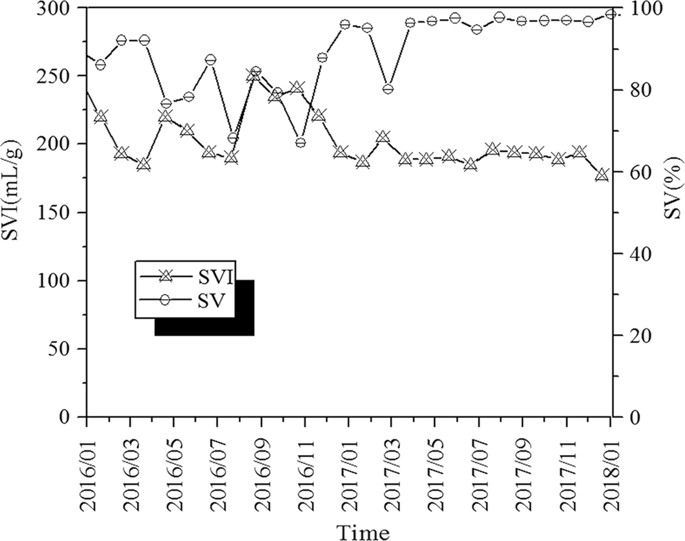Our official English website, www.x-mol.net, welcomes your
feedback! (Note: you will need to create a separate account there.)
The microbial community in filamentous bulking sludge with the ultra-low sludge loading and long sludge retention time in oxidation ditch.
Scientific Reports ( IF 3.8 ) Pub Date : 2019-09-23 , DOI: 10.1038/s41598-019-50086-3 Meng Zhang 1 , Junqin Yao 1 , Xiyuan Wang 1 , Ying Hong 1 , Yinguang Chen 1, 2
Scientific Reports ( IF 3.8 ) Pub Date : 2019-09-23 , DOI: 10.1038/s41598-019-50086-3 Meng Zhang 1 , Junqin Yao 1 , Xiyuan Wang 1 , Ying Hong 1 , Yinguang Chen 1, 2
Affiliation

|
Sludge bulking is a major problem that restricts the development of the activated sludge process. The microbial community responsible for sludge bulking varies depending on water quality and operational conditions. This study analysed the microbial community of bulking sludge in oxidation ditch with ultra-low sludge loading and long sludge retention time using high-throughput sequencing. The study found that the relative abundance of bacterial genus Saprospiraceae_norank was the highest in bulking sludge, reaching 13.39-28.83%, followed by Comamonadaceae_unclassified, Ardenticatenia_norank and Tetrasphaera, with the relative abundance of 4.59-11.08%, 0.52-16.60% and 0.17-8.92% respectively. In contrast, the relative abundance of bacteria that easily caused sludge bulking including Microthrix (0.54-2.47%), Trichococcus (0.32-1.71%), Gordonia (0.14-1.28%), and Thiothrix (0.01-0.06%) were relatively low. Saprospiraceae_norank was predominant and induced sludge bulking in oxidation ditch. The relative abundance of fungal genus Trichosporon was the highest in bulking sludge, reaching 16.95-24.98%, while other fungal genera were Saccharomycetales_unclassified (5.59-14.55%), Ascomycota_norank (1.45-13.51%), Galactomyces (5.23-11.23%), and Debaryomyces (7.69-9.42%), whereas Trichosporon was the dominant fungal genus in bulking sludge. This study reported that excessive Saprospiraceae_norank can induce sludge bulking for the first time, which provides important knowledge to control sludge bulking.
中文翻译:

丝状膨胀污泥中的微生物群落具有超低的污泥负荷和长的污泥在氧化沟中的保留时间。
污泥膨胀是一个主要问题,它限制了活性污泥工艺的发展。负责污泥膨胀的微生物群落因水质和运行条件而异。这项研究使用高通量测序分析了氧化沟中污泥的微生物群落,这些污泥具有超低的污泥负荷和长的污泥保留时间。研究发现,腐泥菌属细菌的相对丰度在散装污泥中最高,达到13.39-28.83%,其次是Comamonadaceae_unclassed,Adenticatenia_norank和Tetrasphaera,相对丰度为4.59-11.08%,0.52-16.60%和0.17-8.92 % 分别。相比之下,容易引起污泥膨胀的细菌相对丰富,包括Microthrix(0.54-2.47%),Trichococcus(0.32-1.71%),Gordonia(0。14-1.28%)和硫磷(0.01-0.06%)相对较低。Saprospiraceae_norank在氧化沟中占主导地位,并导致污泥膨胀。真菌属Trichosporon的相对丰度在散装污泥中最高,达到16.95-24.98%,而其他真菌属为Saccharomycetales_unclassed(5.59-14.55%),Ascomycota_norank(1.45-13.51%),Galactomyces(5.23-11.23%)和拟杆菌属(Debaryomyces)(7.69-9.42%),而曲霉菌属(Trichosporon)是散装污泥中的主要真菌类。这项研究报告说,过量的腐生菌科植物(Saprospiraceae_norank)可以首次引起污泥膨胀,这为控制污泥膨胀提供了重要的知识。真菌属Trichosporon的相对丰度在散装污泥中最高,达到16.95-24.98%,而其他真菌属为Saccharomycetales_unclassed(5.59-14.55%),Ascomycota_norank(1.45-13.51%),Galactomyces(5.23-11.23%)和拟杆菌属(Debaryomyces)(7.69-9.42%),而曲霉菌属(Trichosporon)是散装污泥中的主要真菌类。这项研究报告说,过量的腐生菌科植物(Saprospiraceae_norank)可以首次引起污泥膨胀,这为控制污泥膨胀提供了重要的知识。真菌属Trichosporon的相对丰度在散装污泥中最高,达到16.95-24.98%,而其他真菌属为Saccharomycetales_unclassed(5.59-14.55%),Ascomycota_norank(1.45-13.51%),Galactomyces(5.23-11.23%)和拟杆菌属(Debaryomyces)(7.69-9.42%),而曲霉菌属(Trichosporon)是散装污泥中的主要真菌类。这项研究报告说,过量的腐生菌科植物(Saprospiraceae_norank)可以首次引起污泥膨胀,这为控制污泥膨胀提供了重要的知识。
更新日期:2019-09-23
中文翻译:

丝状膨胀污泥中的微生物群落具有超低的污泥负荷和长的污泥在氧化沟中的保留时间。
污泥膨胀是一个主要问题,它限制了活性污泥工艺的发展。负责污泥膨胀的微生物群落因水质和运行条件而异。这项研究使用高通量测序分析了氧化沟中污泥的微生物群落,这些污泥具有超低的污泥负荷和长的污泥保留时间。研究发现,腐泥菌属细菌的相对丰度在散装污泥中最高,达到13.39-28.83%,其次是Comamonadaceae_unclassed,Adenticatenia_norank和Tetrasphaera,相对丰度为4.59-11.08%,0.52-16.60%和0.17-8.92 % 分别。相比之下,容易引起污泥膨胀的细菌相对丰富,包括Microthrix(0.54-2.47%),Trichococcus(0.32-1.71%),Gordonia(0。14-1.28%)和硫磷(0.01-0.06%)相对较低。Saprospiraceae_norank在氧化沟中占主导地位,并导致污泥膨胀。真菌属Trichosporon的相对丰度在散装污泥中最高,达到16.95-24.98%,而其他真菌属为Saccharomycetales_unclassed(5.59-14.55%),Ascomycota_norank(1.45-13.51%),Galactomyces(5.23-11.23%)和拟杆菌属(Debaryomyces)(7.69-9.42%),而曲霉菌属(Trichosporon)是散装污泥中的主要真菌类。这项研究报告说,过量的腐生菌科植物(Saprospiraceae_norank)可以首次引起污泥膨胀,这为控制污泥膨胀提供了重要的知识。真菌属Trichosporon的相对丰度在散装污泥中最高,达到16.95-24.98%,而其他真菌属为Saccharomycetales_unclassed(5.59-14.55%),Ascomycota_norank(1.45-13.51%),Galactomyces(5.23-11.23%)和拟杆菌属(Debaryomyces)(7.69-9.42%),而曲霉菌属(Trichosporon)是散装污泥中的主要真菌类。这项研究报告说,过量的腐生菌科植物(Saprospiraceae_norank)可以首次引起污泥膨胀,这为控制污泥膨胀提供了重要的知识。真菌属Trichosporon的相对丰度在散装污泥中最高,达到16.95-24.98%,而其他真菌属为Saccharomycetales_unclassed(5.59-14.55%),Ascomycota_norank(1.45-13.51%),Galactomyces(5.23-11.23%)和拟杆菌属(Debaryomyces)(7.69-9.42%),而曲霉菌属(Trichosporon)是散装污泥中的主要真菌类。这项研究报告说,过量的腐生菌科植物(Saprospiraceae_norank)可以首次引起污泥膨胀,这为控制污泥膨胀提供了重要的知识。






























 京公网安备 11010802027423号
京公网安备 11010802027423号